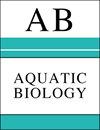研究表面活性剂对蓝贻贝颗粒清除率和捕获效率的影响
IF 0.8
4区 生物学
Q3 MARINE & FRESHWATER BIOLOGY
引用次数: 2
摘要
悬浮摄食双壳类软体动物在其摄食活动中通过耦合远洋和底栖系统发挥了重要的生态作用。颗粒捕获,因此取食,是依赖于颗粒的接触和保留在鳃丝,有几个因素影响这一过程。在过去的30年里,不同类型的合成微球已经被用来研究双壳类动物的颗粒捕获和摄入方面。这项工作的批评者认为,人造颗粒可能含有表面活性剂,这是制造中常用的降低表面张力的化学物质,可能会产生虚假的捕获和摄入率。这项工作的目的是通过实验评估不同类型的表面活性剂在聚苯乙烯颗粒上的存在是否会对蓝贻贝贻贝的颗粒捕获产生瞬时影响。考察了三种常用表面活性剂(十二烷基硫酸钠、苯扎氯铵、Triton-X)对废水清除率(CR)和捕集效率(CE)的影响。结果表明,表面活性剂处理对CR均无影响,其中一种表面活性剂(Triton-X)处理显著降低了3 μm尺寸球体的CE。与对照处理相比,其他测试的表面活性剂都没有显著影响CE。这些数据增加了对双壳类动物处理颗粒的理解,并表明在用于实验的市售微球上发现的表面活性剂浓度或在环境中发现的表面活性剂浓度对喂食过程几乎没有直接影响。本文章由计算机程序翻译,如有差异,请以英文原文为准。
Examining effects of surfactants on particle clearance rate and capture efficiency of the blue mussel Mytilus edulis
Suspension-feeding bivalve molluscs perform important ecological roles by coupling pelagic and benthic systems during their feeding activities. Particle capture, and thus feeding, is dependent on particle encounter and retention on the gill filaments, with several factors influencing this process. Over the past 30 yr, different types of synthetic microspheres have been used to examine aspects of particle capture and ingestion by bivalves. Critics of this work have posited that manufactured particles may contain surfactants, chemicals commonly used in manufacturing to reduce surface tension, that could produce spurious capture and ingestion rates. The goal of this work was to experimentally assess whether the presence of different types of surfactants on manufactured polystyrene particles can result in instantaneous effects on particle capture by the blue mussel Mytilus edulis. The effects of 3 different types of common surfactants (sodium dodecyl sulfate, benzalkonium chloride, Triton-X) on clearance rates (CR) and capture efficiencies (CE) were tested. Results indicated that none of the surfactant treatments had an effect on CR. Treatment with one of the surfactants (Triton-X) significantly lowered CE for 3 μm sized spheres compared to the control spheres (Milli-Q treated). None of the other tested surfactants significantly affected CE when compared to the control treatment. These data add to an understanding of particle handling by bivalves, and suggest that concentrations of surfactants found on commercially available microspheres used for experiments or found in the environment have little immediate effect on feeding processes.
求助全文
通过发布文献求助,成功后即可免费获取论文全文。
去求助
来源期刊

Aquatic Biology
生物-海洋与淡水生物学
CiteScore
2.70
自引率
0.00%
发文量
7
审稿时长
3 months
期刊介绍:
AB publishes rigorously refereed and carefully selected Feature Articles, Research Articles, Reviews and Notes, as well as Comments/Reply Comments (for details see MEPS 228:1), Theme Sections, Opinion Pieces (previously called ''As I See It'') (for details consult the Guidelines for Authors) concerned with the biology, physiology, biochemistry and genetics (including the ’omics‘) of all aquatic organisms under laboratory and field conditions, and at all levels of organisation and investigation. Areas covered include:
-Biological aspects of biota: Evolution and speciation; life histories; biodiversity, biogeography and phylogeography; population genetics; biological connectedness between marine and freshwater biota; paleobiology of aquatic environments; invasive species.
-Biochemical and physiological aspects of aquatic life; synthesis and conversion of organic matter (mechanisms of auto- and heterotrophy, digestion, respiration, nutrition); thermo-, ion, osmo- and volume-regulation; stress and stress resistance; metabolism and energy budgets; non-genetic and genetic adaptation.
-Species interactions: Environment–organism and organism–organism interrelationships; predation: defenses (physical and chemical); symbioses.
-Molecular biology of aquatic life.
-Behavior: Orientation in space and time; migrations; feeding and reproductive behavior; agonistic behavior.
-Toxicology and water-quality effects on organisms; anthropogenic impacts on aquatic biota (e.g. pollution, fisheries); stream regulation and restoration.
-Theoretical biology: mathematical modelling of biological processes and species interactions.
-Methodology and equipment employed in aquatic biological research; underwater exploration and experimentation.
-Exploitation of aquatic biota: Fisheries; cultivation of aquatic organisms: use, management, protection and conservation of living aquatic resources.
-Reproduction and development in marine, brackish and freshwater organisms
 求助内容:
求助内容: 应助结果提醒方式:
应助结果提醒方式:


